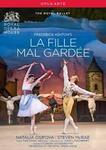|
Back
01/06/2016
Ferdinand Hérold (arr. John Lanchbery): La Fille mal gardée
Natalia Osipova (Lise), Steven McRae (Colas), Philip Mosley (Widow Simone), Christopher Saunders (Thomas), Paul Kay (Alain), Corps de Ballet and Orchestra of the Royal Opera House, Vasko Vassilev (Concertmaster), Barry Wordsworth (Conductor), Choreography (Sir Frederick Ashton after Jean Dauberval), Sir Osbert Lancaster (Set and Costume Designer), John B. Read (Lighting Designer), Ross MacGibbon (Video Director)
Recording: Royal Opera House, Covent Garden, London, England (May 5, 2015) – 124’ (including 14 min. bonus)
Opus Arte #OA 1196 (or Blu-Ray #OA BD7187D) – Dolby Stereo/DTS Surround – Format NTSC 16:9 – Region 0 – Booklet in English, French and German (Distributed by Naxos of America)

   
Eyeing Pierre-Antoine Baudoin’s 1789 painting, La Réprimande/Une jeune fille querellée par sa mère, was all Jean Dauberval needed to inspire his comic ballet, La Fille mal gardée. Originally comprised of a pastiche of 55 French airs, the piece opened in England in 1791 at The Ballet of the King’s Pantheon Theatre. It was severely spurned by the musicians themselves and tucked away until 1959 when John Lanchbery and ballet historian/musicologist Ivor Guest discovered this harshly ridiculed score. Together with choreographer, Sir Frederick Ashton, the team began a revised production which premiered on January 28, 1960.
To this day La Fille mal gardée is firmly entrenched inside the British repertory with plenteous Lise/Colas pairings. Natalia Osipova and Steven McRae have an endearing union that emphasizes the English style of dancing which Sir Frederick Ashton adamantly desired.
If personality finds its true connection inside a dancer’s role, it can make a difference between “good” and “sensational.” In the bonus supplement Osipova openly admits to being fun and a bit mischievous at times: in La Fille mal gardée she can “be herself.” Her Lise is sprite, demonstrating beautiful cadences and smoothly developed positions. Particularly important is pantomiming, and throughout the Petipa-derived “When I’m Married” number the audience feels Osipova’s heart-felt hopes.
Warm gesticulations are further strengthened when joined by Steven McRae as Colas. His love for Lise renders a tad coy though brimming with puppy love. McRae’s executions are razor-precise, delivering mathematical incisiveness (i.e. the wine bottle dance) while rounding out the clean sharpness with pliancy. Their execution of “The Fanny Elssler pax de deux” shows grace and smoothness while the Pas de ruban demonstrates Osipova’s and McRae’s nuanced dexterity using gardée’s trademark ribbons.
Philip Mosley’s caricature expresses fittingly. He understates Widow Simone which adds to the plot’s absurdities, and he has unabashed fun during the “Clog Dance.” The half-dimwitted Alain dances his way through the ballet with amusement mannerisms: Paul Kay doesn’t miss a beat when it comes to his Gumbyesque elasticity. The red umbrella, a key prop associated with his character, adds witty reminders, especially when he returns in the closing seconds, aligning himself with that of Mahomet from Strauss’ Der Rosenkavalier...Kay is fully coordinated and fully cued.
Thanks to designs for The D’Oyly Carte Opera Company, Osbert Lancaster made his own contributions to the Ashton camp early on. Here we find his two-dimensional watercolor-like sets bathed in vibrant translucency and whimsical optimism. Accentuate this with costuming taking pastel coloring to another level; the scenic backdrops are bubbly.
Barry Wordsworth brings a fine and unobtrusive interpretation from the orchestra pit. For those of the opera persuasion, one can’t help but feel as though we’re following a loose lining of a Rossini comic opera. While John Lanchbery tweaked Hérold’s music (and at the behest of Ashton) by adding his own personal touches, early on in Act I we, in fact, hear truncated sections of Il barbiere.
The corps de ballet is a strong entity which supports all principals. The cleverly complex "Maypole Dance" flows while a contingent of poultry adds to the farm antics during the amusing "Dance of the Cock and Hens."
Chemistry is key to many an artistic production. The same can be said about this La Fille mal gardée with its endless amount of unstoppable zest.
Christie Grimstad
|